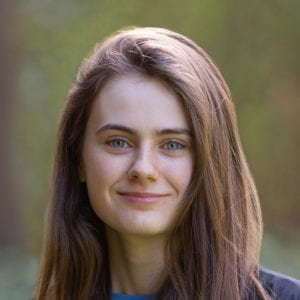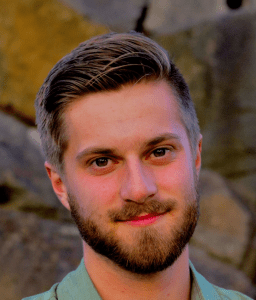The Fire Story: Season 2
Season Two of The Fire Story follows two student producers on a journey through home building, community resiliency, and policymaking in the face of fire. Multimedia producers and journalism students Eden McCall and Noah Camuso spent one year developing this work in an effort to get to the complex stories of living with wildland fire.


How to use this site
Student producers Eden McCall and Noah Camuso have developed transcripts that go along with each episode. In each transcript, you will find additional information about topics covered, sources used, and related information. Our goal is to provide transparent and robust reporting, so you can see all the information that went into the production of each episode. McCall and Camuso also produced a Media Scan, which links related podcasts, media coverage, and agency websites, and provides a list of key terms.
About this series
This series is intended for all Oregonians. It explores wildfire issues and, most importantly, potential avenues for solutions. No prior knowledge is needed about wildfire, but each episode provides a depth of information about wildfire science, homeowners insurance and the country’s history of natural hazard preparation to engage even those with extensive wildfire policy knowledge. The goal is to encourage Oregonians to prepare their property and family for wildfires and to guide community planners and politicians toward better fire preparedness. Thus, each episode requires no prior knowledge about wildfire but provides a depth of information about wildfire science, homeowners insurance, and the country’s history of natural hazard preparation to engage even those with extensive wildfire policy knowledge.
The series, which aims to provide established and emerging communication professionals and the public with a more nuanced understanding of wildfire’s multiple dimensions through the lens of recent wildland fires in Oregon, is possible due to the generous support of our partners and funders:
- The Julie and Rocky Dixon Investigative Reporting Fund is administered by SCR through the UO School of Journalism and Communication.
- The Northwest Fire Science Consortium is a regional fire science delivery system for disseminating knowledge and tools; a framework for coordinating fire science delivery; and a venue for increasing researcher understanding of the needs of managers & practitioners.
- The Institute for a Sustainable Environment is a center for innovative, interdisciplinary research at the nexus of ecological, economic, and social sustainability.
Episodes
Episode 0: Season Two Introduction
Introduction: Learn more about The Fire Story Season Two and the two University of Oregon journalism students behind the series.
Episodes 1 & 2 by Noah Camuso
The first two episodes highlight disparate stakeholders coming together to mitigate fire risk in Oregon’s forests and neighborhoods. By interviewing a range of wildfire professionals, scientists, developers and others, the episodes cover examples of two major approaches to mitigating fire risk: forest management and fire-resilient housing.
Episode 1: Collaboratives
How can forest collaboratives help restore landscapes to their previous levels of wildfire resilience?
This episode will talk about the role forest collaboratives play in active forest management by highlighting one based out of John Day, Oregon, called the Blue Mountains Forest Partners (BMFP.) Weaving together interviews with ecologists, members of the USFS, environmentalists, and loggers, the story will dive into how scientists reconstruct the fire history of the Malheur National Forest, and how that research brings together disparate stakeholders.
From there, we’ll learn about a historic rule that was changed in 2021 and how the Blue Mountains Forest Partners help to facilitate similar changes in forest management policy to keep up with leading science on fire resilience
Episode 2: Building for fire
How should we approach new development in wildfire-prone areas?
The Wildland-Urban Interface, or the WUI, is the transition zone between human development and wildlands where wildfires pose the biggest threat to people. Between 1990 and 2010, it was the fastest-growing land-use area in America, growing from 30.8 million homes to 43.3 million homes.
This episode sheds light on a new development west of Bend that may represent a promising shift in how we think about new development in wildfire-prone areas. Tune in to hear about how efforts made by environmentalists, landowners, developers, and the city of Bend resulted in a wildfire-resilient neighborhood west of Bend called the Tree Farm Housing development and a new type of zone that was established to prevent dense development in areas that are prone to wildfire.
Episodes 3, 4, & 5 by Eden McCall
The final three episodes investigate the 2020 Almeda Fire, Oregon’s first urban wildfire, to uncover how wildfires are changing in the Western United States and why these changes will disproportionately impact Oregonians with the fewest resources most of all.
Weaving together interviews with fire experts, community planners and representatives, and a local builder, the series highlights how individuals and communities can adapt to live alongside fire.
Episode 3: Only a matter of time – Oregon’s first urban wildfire
How did a small grass fire turn into Oregon’s most destructive wildfire?
Returning to the initial radio dispatch for a grass fire north of Ashland, Oregon, this episode follows the path of the Almeda Fire as it traveled northward and through the towns of Talent and Phoenix to discover why Oregon’s first urban wildfire overwhelmed firefighting resources but didn’t surprise firefighting experts.
After diving into the science of wildfire risk perception and coming to understand why many Oregonians don’t think a fire will burn nearby until it’s too late, in a neighborhood just north of the edge of the burn, one fire marshal will explain his years-long battle to change how Oregon prepares for wildfire across the state.
Episode 4: Challenges and opportunity – Rebuilding after wildfire
What happens after a wildfire burns through a community?
This episode returns to Talent a year and a half after the Almeda Fire destroyed thousands of homes to discover how Oregonians are rebuilding and recovering after the Almeda Fire, and why many homes aren’t being rebuilt as fire-resistant as they could be despite persistent fire danger.
The story also highlights how many LatinX, elderly, and economically disadvantaged Oregonians were impacted more by the urban wildfire.
After hearing about challenges with permitting, insurance, and supply shortages, one local builder will demonstrate how simple material switches can ensure future homes are rebuilt to withstand wildfires.
Episode 5: Fire & floods
Why is Talent being rebuilt flood-resistant but not fire-resistant?
Returning to the start of the 20thcentury, this final episode explores how the nation’s history with flooding and fire is shaping the way communities are built back after disasters today and offers insights into why progress in flood preparedness could guide wildfire preparedness today.
Expanding beyond Oregon, the episode travels south, to the populated hillsides of California, to discover the role insurance plays in the fire problem.
Then, combining archival clips with recent legislative and Congressional meetings, the story offers audiences a chance to reflect on the current state and federal policy aimed to address the wildfire problem.